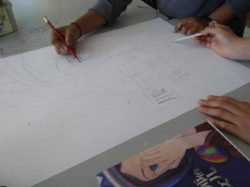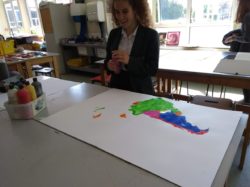Teaching the Ventriloquist's Daughter (5 and 6)
We are delighted that our Teaching Consultant and Advisory  Board member Dr Theresa Munford, of St Gregory's School in Bath, has created a blog series for us on the practicalities of using an authentic text to create a Y10 scheme of work. The text she has chosen is The Ventriloquist’s Daughter by Lin Man-chiu, translated by Helen Wang.
Board member Dr Theresa Munford, of St Gregory's School in Bath, has created a blog series for us on the practicalities of using an authentic text to create a Y10 scheme of work. The text she has chosen is The Ventriloquist’s Daughter by Lin Man-chiu, translated by Helen Wang.
Parts 5 and 6. 25th and 29th June 2018
Lesson 5: Writing -- peer assessment
Rationale:
The new GCSE is going to involve a much more difficult writing challenge than the old style controlled assessment; the students will need lots more practice at writing so they can undertake unsupported tasks in the exam.
At this stage in their learning the most common mistakes are word order. By looking at each others’ post cards and seeing if they can spot word order errors etc they have an excellent way of boosting their ability to edit their own work. This is a supportive class so they are able to peer assess without feeling undermined.
The quizlet set gives them some words they encountered in last week’s ‘Argentinian Bride’ TCB article which are on the GCSE syllabus, plus some of the key words to do with continents (Asia, Central America etc etc)
Review:
The postcards they wrote for their homework turned out to be a really useful writing exercise as the exercise was ‘self contained’, threw up lots of basic sentence patterns and common mistakes (eg 和 not joining clauses) and they had all risen to the challenge of finding interesting transliterations of scenic spots in the countries they had chosen to write a postcard from. Some of them revealed wonderful talent as artists as they had drawn the postcard view they wanted to use. (It’s always nice to see the different skills our students have and which don’t always come to light in day-to-day lessons)
Lesson 6: A Display
Rationale:
 In learning terms, this gives them an opportunity to familiarize themselves with the geography of South and Central America (cross curricular), the characters on the cover of the book, and also their resourcefulness in designing a display. It’s also nice to treat them to a lesson in the art room as the term winds down. And, from a teacher’s point of view, we need fresh and impressive displays ready for September when the open evening round begins and we rarely have time to think about displays at the start of the new school year!
In learning terms, this gives them an opportunity to familiarize themselves with the geography of South and Central America (cross curricular), the characters on the cover of the book, and also their resourcefulness in designing a display. It’s also nice to treat them to a lesson in the art room as the term winds down. And, from a teacher’s point of view, we need fresh and impressive displays ready for September when the open evening round begins and we rarely have time to think about displays at the start of the new school year!
Review:
 They surprised me with their resourcefulness and ability to work as a team. While I was pondering how to do the map, they had already worked out that the easiest way was to project a map on the smart board and trace over it. Two others set to work reproducing a larger version of the book cover, and one worked on doing character signs for the features in her postcard (山,教堂,河 etc). It turned out to be one of those perfect lessons from a teacher’s point of view where all I had to do was be their ‘juke box’ and finding the music tracks they wanted to listen to while they worked!
They surprised me with their resourcefulness and ability to work as a team. While I was pondering how to do the map, they had already worked out that the easiest way was to project a map on the smart board and trace over it. Two others set to work reproducing a larger version of the book cover, and one worked on doing character signs for the features in her postcard (山,教堂,河 etc). It turned out to be one of those perfect lessons from a teacher’s point of view where all I had to do was be their ‘juke box’ and finding the music tracks they wanted to listen to while they worked!
Downloads:
Vocab test weather and scenery
